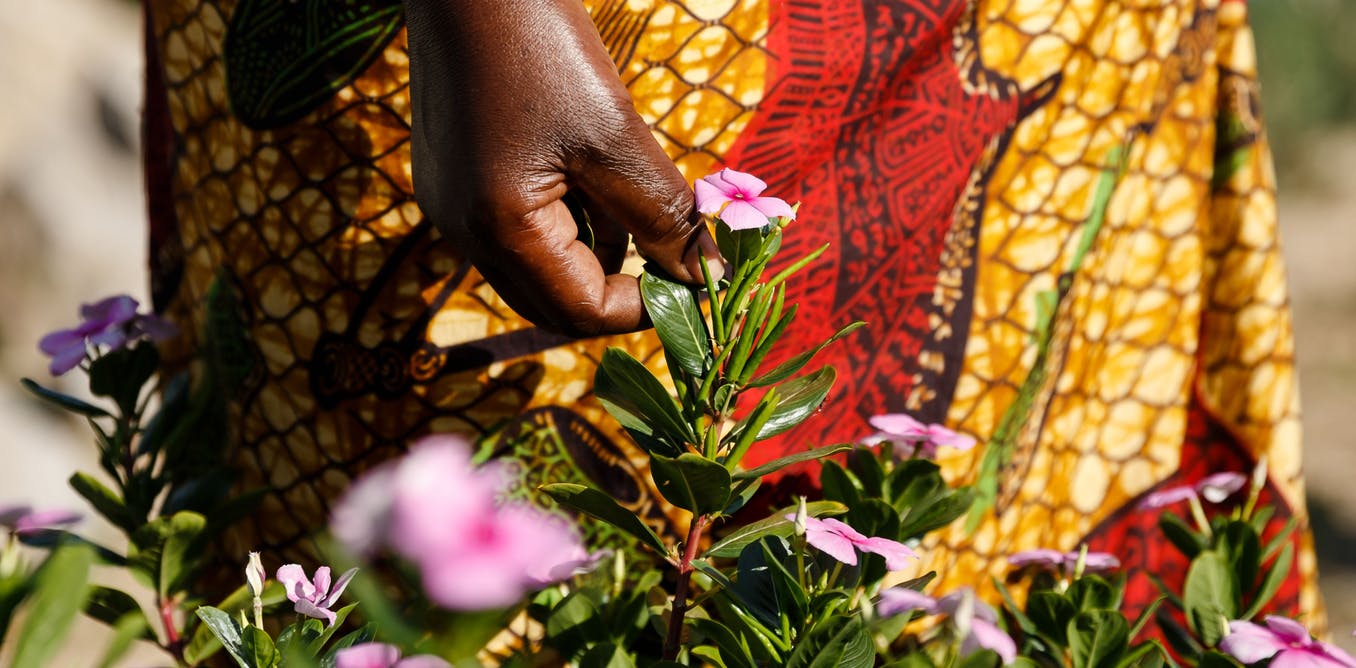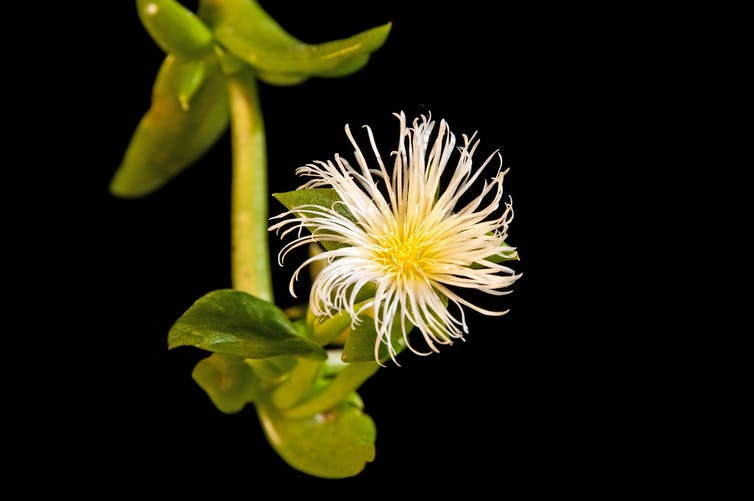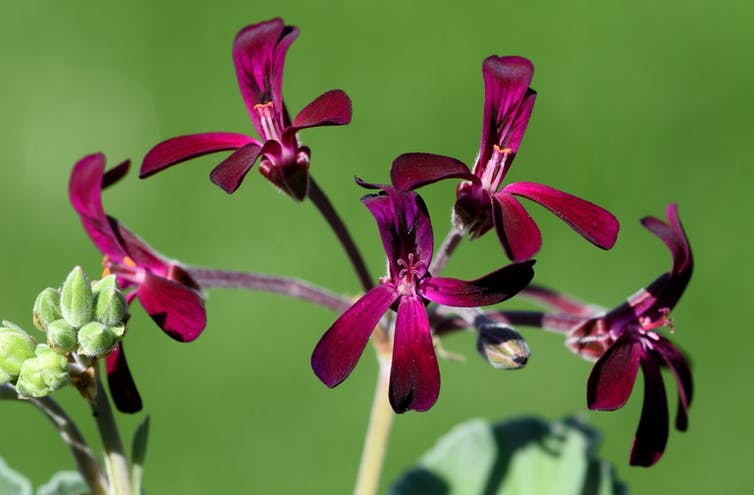Africa is a treasure trove of medicinal plants: here are seven that are popular

Plants have directly contributed to the development of important drugs. The antimalarial treatment artemisinin, pain medication morphine, and cancer chemotherapy taxol are just three examples of drugs derived from plants. Africa is endowed with up to 45,000 plant species – about 25% of the world’s plant genetic resources. More than 5,000 plant species from this enormous African resource are used in traditional medicines. Medicinal plant specialists Associate Professor Adeyemi Aremu and Professor Nox Makunga highlight some of these plants.
Artemisia afra.
Dr Marietjie Stander
Artemisia afra Jacq. ex Willd. (African wormwood)
Artemisia afra is the only species in its genus that is indigenous to the African continent. It’s often regarded as a potential flagship plant because of its high popularity and diverse uses in African traditional medicine.
African wormwood has been used for coughs, colds, influenza and malaria.
Scientific evidence of its antimicrobial, anti-depressant, antioxidant and anti-inflammatory effects has been reported. African wormwood gained global interest when it was promoted as having potential to treat COVID-19 and was tested in laboratory studies. The extracts had some degree of inhibitory activity against feline coronavirus and SARS-CoV-2. But this requires further clinical study to reach a valid conclusion.
The traditional uses and increasing popularity of African wormwood have resulted in a number of commercial herbal products. But with insufficient clinical data, it’s not yet known whether African wormwood is a treasure chest of new drugs.
Catharanthus roseus (L.) G.Don
This plant is also known as bright eyes, Cape periwinkle, graveyard plant, Madagascar periwinkle, old maid, or pink periwinkle. It is native and endemic to Madagascar. The plant is commonly used as a tonic and emetic for the treatment of many health conditions including rheumatism, diabetes, and skin-related and venereal diseases.

Catharanthus roseus, commonly known as bright eyes, Cape periwinkle, graveyard plant, Madagascar periwinkle.
Shutterstock
Pink periwinkle has several phytochemicals which are associated with antioxidant, antimicrobial, antidiabetic and anticancer properties. Alkaloids remain one of the signature. Two of its alkaloids, vincristine and vinblastine, have been extensively explored by the pharmaceutical industry. These two alkaloids were the first plant-derived anticancer agents deployed for clinical use.
Griffonia simplicifolia (DC.) Baill. (Griffonia, Atooto, gbogbotri, kajya, kanya, kwakuo-aboto)
Griffonia simplicifolia is a woody climbing shrub. It is native to west and central African countries including Benin, Cameroon, Côte d’Ivoire, Gabon, Ghana, Liberia, Nigeria and Togo. In African traditional medicine, the seeds are reputed to exert several medicinal effects and have been explored as an aphrodisiac, and a remedy for diarrhoea, stomach ache and dysentery.
The plant’s chemical properties have been studied extensively. It has been found to contain rich phytochemicals with enormous pharmaceutical value. Particularly, the seeds are known as an excellent source of 5-hydroxy-L-tryptophan (commercially called oxitriptan) which the body uses to produce serotonin. Serotonin is a neurotransmitter which is known to affect sleep, appetite, pain and mood. It plays an important role in treating depression, insomnia, obesity and related health conditions, especially those associated with mental health.
The seed of Griffonia simplicifolia remains one of the most reliable and abundant sources. Commercial interest has increased over the years. Based on recent estimates, the market value for annual bulk seed extract for the plant is between US$32 million and US$100 million and demand is expected to grow at 7% per year.

Sceletium tortuosum or Kanna blooming.
Shutterstock
Sceletium tortuosum (L.) N.E.Br. (kanna, kougoed)
Kanna is an endemic South African succulent. It is sparsely distributed in semi-arid areas and used for conditions relating to stress, depression, pain and anxiety. Mesembrine-type alkaloids are dominant and typically responsible for the pharmacological effects exerted by kanna as a psychoactive plant and mood stimulant. Zembrin® has been developed as a standardised extract of the plant. It’s used as a dietary supplement with the potential to elevate mood, relieve stress and improve cognition. The use of this species stems from the traditions of the Khoekhoe and San.
Many other medicinal uses have been reported for this species as it can be used to treat headaches, abdominal pains and respiratory ailments. Trimesemine™ (a commercially available extract high in concentrations of mesembrine) has been shown to act as a monoamine releaser, by increasing serotonin, a chemical messenger that is produced by the body that is also known to regulate the mood. It is potentially useful for attention deficit and other central nervous system disorders such as Alzheimer’s disease.
Strophanthus gratus (Wall.and Hook.) Baill. (Climbing oleander)
Strophanthus gratus, a vigorous evergreen climbing shrub, occurs in tropical regions from Senegal to the Democratic Republic of the Congo. In traditional medicine, climbing oleander has been used to treat snake bites, sores, gonorrhoea, constipation and fever. The root is claimed to be an aphrodisiac.
Cardiac glycosides, which are organic compounds that increase the output force of the heart, are the signature compounds in the plant. Particularly, ouabain has been identified as the main glycoside which is dominant in the seed.
Ouabain, a cardio glycoside, was isolated because of the way climbing oleander is used in traditional medicine. It’s now used as a treatment for heart failure and arrhythmias or irregular heartbeat. Recent studies have also found a novel use that can prove relevant for metastatic prostate cancer.

Pelargonium sidoides also known as African geranium or South African geranium.
Shutterstock
Pelargonium sidoides DC (African geranium, South African geranium)
This medicinal geranium which is indigenous to South Africa and the Lesotho highlands has root tubers that are harvested for medicinal purposes. People use these tubers for diarrhoea, colic, gastritis, tuberculosis, cough, liver disorders, menstrual complaints, gonorrhoea, and many other medical conditions.
Clinical evidence suggests the effectiveness of extracts prepared from this species for the management of acute respiratory tract infections. These data support the use of this medicinal geranium especially for alleviating symptoms of acute inflammation of the nasal cavity and sinuses and the common cold in adults. Umckaloabo® (EPs® 7630), a standardised proprietary extract, is one of most successfully produced plant-derived pharmaceuticals from this species. A number of clinical studies have shown it can reduce the symptoms of acute bronchitis.
Over-the-counter medications (Kaloba and Umcka) made from extracts of this pelargonium are now sold all over the world. Linctagon® is a pelargonium-inspired medication that is prescribed to assist the body to fight colds and flu by stimulating the immune system.
Siphonochilus aethiopicus (Schweinf.) B.L. Burtt (African ginger, Wild ginger)
African ginger is native to western and southern tropical Africa, where it occurs in about 30 African countries. This wide range of distribution likely accounts for its use for a variety of health conditions. These include respiratory problems (like cough and influenza), pain, inflammation and malaria.
An analysis of the essential oil of the root and rhizome of African ginger found about 70 compounds in the root and 60 compounds in the rhizomes. The bioactive compounds siphonochilone and eucalyptol found in the roots and rhizomes have demonstrated potential for treating asthma and allergic reactions. In a clinical trial, eucalyptol, which is present in root and rhizome essential oil, has demonstrated anti-inflammatory activity in bronchial asthma.
In South Africa, this species is classified as critically endangered because it has been over-harvested for traditional medicine. This species is fast headed towards extinction in South Africa in the wild. Cultivation is strongly encouraged for its conservation.






